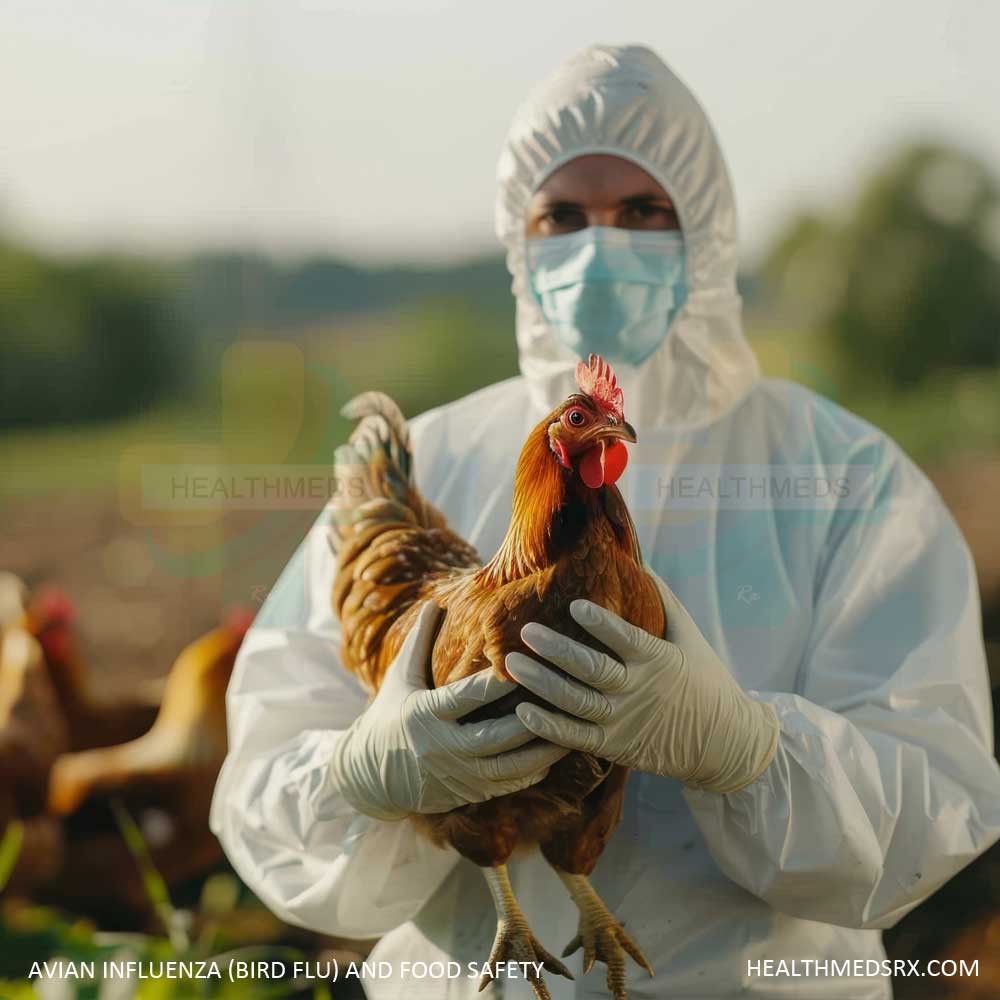In recent years, Avian Influenza, commonly known as Bird Flu, has become a growing concern worldwide. Outbreaks have affected poultry farms in the U.S. and other parts of the world, making people worried about food safety, especially with chicken, turkey, and eggs. But how concerned should we be? Can you get Avian Influenza (Bird Flu) from eating poultry? What should you do to protect yourself and your family?
In this guide, we will learn what avian influenza is, how it affects the poultry industry, the risks to humans, and important food safety tips to keep you safe and informed.
What is Avian Influenza (Bird Flu)?
Avian influenza is a highly contagious virus that mainly affects birds, especially poultry like chickens, ducks, and turkeys. It is part of the Orthomyxoviridae family and has many subtypes, with H5N1 and H7N9 being the most concerning strains because they can potentially infect humans.
Bird flu mostly spreads among birds when they come into contact with infected saliva, nasal secretions, and feces. Infected wild birds can transmit the virus to domestic poultry, leading to widespread outbreaks and severe economic losses in the poultry industry.
Typically, bird flu does not infect humans, but some strains can cause serious respiratory problems and even death in rare cases of human transmission.
History and Outbreaks
Avian influenza, or bird flu, is a serious threat to animal and human health, primarily affecting birds but capable of infecting humans through certain strains. The first major outbreak occurred in 1997 in Hong Kong with the H5N1 strain, leading to the culling of millions of chickens and raising concerns about potential pandemics.
Subsequent strains like H7N9 and H5N8 have also caused significant economic losses in the poultry industry and occasional human cases.
The 2014-2015 H5N8 outbreak in the U.S. led to the culling of over 50 million birds and billions in losses. While most human cases result from direct contact with infected birds, the risk of the virus evolving for easier human transmission remains a major public health concern, highlighting the need for continuous monitoring and cooperation.
Current Status of Avian Influenza Outbreaks in the U.S.
The U.S. has had several outbreaks of avian influenza over the years. The most recent outbreaks have led to the mass culling of millions of poultry birds to prevent further spread. Some important points are:
- More cases have been reported in poultry farms and backyard flocks.
- Prices for poultry and eggs are increasing due to supply chain issues.
- The U.S. Department of Agriculture (USDA) is enforcing stricter biosecurity measures to manage these outbreaks.
Even with these problems, the USDA and FDA are still watching and regulating poultry production to ensure only safe products reach grocery shelves.
Can Humans Get Bird Flu from Eating Poultry?
One of the biggest questions surrounding avian influenza is whether consuming poultry products poses a health risk. The short answer is NO—if food is handled and cooked properly.
The CDC and WHO emphasize that bird flu does not spread through properly cooked food. The virus is destroyed at high temperatures, meaning fully cooked poultry and eggs are safe to eat.
However, contamination can occur if raw poultry comes into contact with other foods or surfaces. Therefore, proper food handling practices are essential.
Symptoms and Risks of Avian Influenza in Humans
Although rare, human cases of avian influenza have been reported, especially among people who have had direct contact with infected birds. Symptoms in humans may include:
- Fever and chills
- Cough and sore throat
- Shortness of breath
- Muscle aches
- Severe respiratory distress in severe cases
Certain risk factors can increase the chances of contracting bird flu or experiencing more severe symptoms. These include:
- Close contact with infected birds: People who work with poultry, such as farmers, veterinarians, and workers in live bird markets, are at higher risk.
- Weakened immune system: Individuals with compromised immune systems due to conditions like HIV/AIDS, cancer, or organ transplants are more vulnerable. You may read ways on improving immune system when facing issue with weakened immune system.
- Age: Older adults and young children may have a higher risk of severe illness.
- Underlying health conditions: People with chronic medical conditions like diabetes, heart disease, or respiratory disorders are more susceptible to complications.
Food Safety Tips to Protect Yourself from Bird Flu
While the chance of getting bird flu from food is low, it’s always best to follow food safety guidelines to avoid any health issues. Here are some key practices:
- Cook Poultry to a Safe Temperature
-
- Always cook chicken, turkey, and other poultry to an internal temperature of 165°F (74°C) to kill bacteria and viruses.
- Use a food thermometer to measure the temperature in the thickest area of the meat.
- Avoid Cross-Contamination
-
- Keep raw poultry separate from other foods, cutting boards, and utensils.
- Wash hands well with soap and water after handling raw poultry.
- Clean kitchen surfaces and equipment that contact with raw meat.
- Handle Eggs Safely
-
- Don’t eat raw or undercooked eggs, especially in homemade mayonnaise or raw cookie dough.
- Store eggs in the refrigerator at 40°F (4°C) or lower to prevent bacterial growth.
- Purchase from Trusted Sources
-
- Buy poultry and eggs from reliable grocery stores and certified suppliers.
- Look for USDA inspection labels to make sure products are safe.
- Stay Informed on Poultry Recalls
-
- Follow updates from USDA and FDA regarding any food recalls related to avian flu outbreaks.
- If there is a recall, throw away affected products immediately and clean the storage area properly.
Poultry Industry and Food Supply
Avian influenza outbreaks can greatly affect the poultry industry and food supply. When a dangerous strain of the virus is found on a farm, all infected birds must be killed to stop it from spreading. This loss of poultry can disrupt the supply of chicken and eggs, leading to shortages and price increases for consumers.
Besides the direct loss of birds, avian influenza outbreaks can cause trade restrictions and export bans as countries try to keep the virus out. This can have serious economic effects on poultry farmers, especially in areas where a lot of poultry is sold to other countries.
To reduce the risk of bird flu outbreaks and lessen their effects on food supplies, the poultry industry has implemented strict biosecurity measures. These include:
- Enhanced surveillance and monitoring programs to detect the virus early.
- Strict quarantine and movement control for infected farms and surrounding areas.
- Improved hygiene and disinfection protocols for poultry facilities and equipment.
- Increased use of vaccination in some regions to protect flocks.
The Role of Government Agencies in Managing Avian Influenza Risks
Government agencies are important for handling avian influenza (bird flu) risks and keeping the poultry industry and food supply safe. Here are some main ways the government helps deal with this flu outbreaks:
- Government Response to Bird Flu Outbreaks: When bird flu outbreaks happen, government agencies like the the Centers for Disease Control and Prevention (CDC), and state agriculture and health departments take the lead in responding. This includes implementing surveillance and monitoring programs, deploying rapid response teams to affected areas, vaccination programs for birds in high-risk areas, and guiding poultry farmers and producers on disease control measures.
- Food Safety Regulations: Government agencies create and enforce food safety rules to stop bird flu from spreading from chickens to people. They set standards for how poultry is handled, processed, and packaged to reduce the risk of contamination. The Food and Drug Administration (FDA) also ensure that poultry products are safe from the farm to the store.
- USDA Guidelines on Poultry Safety: The USDA plays a crucial role in setting guidelines and regulations related to poultry safety, including measures to prevent and control avian influenza in poultry farms. This includes guiding biosecurity practices, disease surveillance, and the appropriate response to avian influenza outbreaks. The USDA also works with industry stakeholders to develop and implement best practices for safeguarding poultry health, ensuring the safety of poultry products, and minimizing the spread of avian influenza.
Safety Measures to Prevent the Spread of Bird Flu in Poultry Farms
To prevent the spread of bird flu in poultry farms, it is essential to implement robust biosafety protocols, effective poultry farm management practices, disease prevention strategies, and avian influenza control measures. Here are some key safety measures to consider:
Biosafety Protocols:
Establish controlled access to the farm and implement strict entry protocols for personnel, vehicles, and equipment to minimize the introduction of avian influenza viruses.
Maintain biosecurity zones within the farm to control the movement of people, birds, and equipment between different areas.
Implement hygiene measures, including handwashing stations, boot baths, and disinfection procedures to reduce the risk of virus transmission.
Regularly clean and disinfect facilities, equipment, and vehicles to prevent contamination and the spread of avian influenza.
Implement measures to prevent contact between domestic poultry and wild birds, which can carry and transmit avian influenza viruses.
Poultry Farm Management:
Practice effective flock management techniques, such as proper ventilation, adequate spacing, and optimal nutrition, to help maintain the health and immunity of poultry flocks.
Monitor bird health closely, conduct regular health checks, and promptly isolate and treat sick or infected birds to prevent the spread of avian influenza.
Implement proper waste management practices to safely dispose of poultry litter, manure, and carcasses to reduce the risk of environmental contamination.
Disease Prevention Strategies:
Develop and follow vaccination programs recommended by veterinarians to protect poultry flocks from common avian influenza strains.
Monitor and control pests and vectors that can transmit avian influenza viruses, such as rodents, insects, and other animals.
Educate farm workers on the signs and symptoms of avian influenza and the importance of reporting any suspected cases promptly.
Avian Influenza Control Measures:
Implement biosecurity audits and risk assessments regularly to identify and address potential weaknesses in biosafety protocols.
Develop and implement contingency plans for responding to avian influenza outbreaks, including rapid response protocols, quarantine procedures, and communication strategies.
Collaborate with veterinary authorities, government agencies, and industry stakeholders to exchange information, coordinate response efforts, and share best practices for avian influenza control


